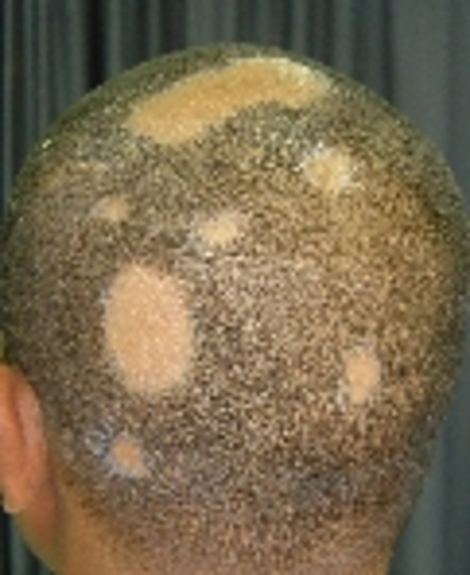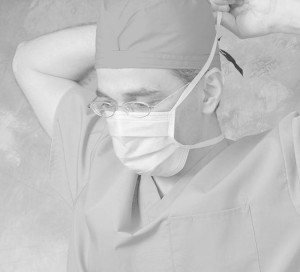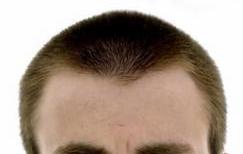Archive for the ‘California hair transplant’ Category
Saturday, September 5th, 2009
 Alopecia Areata (AA) is an autoimmune hair loss condition. It presents itself in the form of patchy hair loss on the scalp or other areas where hair exists. Some have questioned if AA can also be triggered by emotional stress. It has been discussed in some medical journals but the exact mechanism has never been explored. There has been a study conducted and published on the relationship between stress and the pathogenesis of alopecia areata. This was done by subjecting AA-affected and normal lab mice to ether anesthesia (stress) through restraining the animal. Alopecia Areata (AA) is an autoimmune hair loss condition. It presents itself in the form of patchy hair loss on the scalp or other areas where hair exists. Some have questioned if AA can also be triggered by emotional stress. It has been discussed in some medical journals but the exact mechanism has never been explored. There has been a study conducted and published on the relationship between stress and the pathogenesis of alopecia areata. This was done by subjecting AA-affected and normal lab mice to ether anesthesia (stress) through restraining the animal.
The mice with alopecia areata had a marked increase in hypothalamic-pituitary-adrenal tone and activity centrally and peripherally in the skin and lymph nodes. Plasma corticosterone, adrenocorticotropic hormone, and estradiol levels were determined in this study as indicator or stress level, whereas gene expression in brains, lymphoid organs, and skin was measured by quantitative RT-PCR for corticotropin-releasing hormone, arginine vasopressin, proopiomelanocortin, glucocorticoid receptor, mineralocorticoid receptor, corticotropin-releasing hormone receptor types 1 and 2, interleukin-12, tumor necrosis factor-alpha, and estrogen receptors type-1 and type-2.
Compared to normal mice, there was an altered interaction seen between the adrenal and gonadal axis proving that the stress level in those animals was in fact higher. Stress also caused changes in the activity of the hypothalamus pituitary axis in the mice with AA.
In addition, animals with AA had significantly blunted corticosteroid and ACTH responses to acute ether stress (physiological stressor) and a deficit in habituation to repeated restraint stress (psychological stressor). These findings further suggest that altered brain responses caused by stress may be associated with the occurrence of alopecia areata, proving the hypothesis that stress plays an important factor.
Treatment of AA is done through observation of the patient and, in some cases, steroid injections can also prove useful. These treatment options have shown some improvement in those who have extensive types of AA like Alopecia Totalis. We do not recommend any patient to get hair transplant surgery if they have active AA since the chance of losing the newly transplant hair is very likely.
Although AA is not genreally treated with hair restoration, we at our offices of US Hair Restoration in LA, BH and Orange County visit and treat patients of AA in a regular basis.
Tags: AA, ACTH, adrenocorticotropic hormone, alopecia areata, alopeica totalis, arginine vasopressin, Avp, CORT, corticotropin-releasing hormone, estradiol, glucocorticoid receptor, hair loss, hair loss innovations, hair transplant, hair transplant surgery, lymphoid organs, mineralocorticoid receptor, proopiomelanocortin, RT-PCR, sress level
Posted in Beverly Hills hair transplant, California hair transplant, Los Angeles Hair Transplant, Orange County hair transplant | No Comments »
Saturday, August 15th, 2009
 In our previous blogs we’ve touched on the subject of “best hair transplant doctor” and how to choose one. This is one of the most addressed topics so we see it fit to talk about it once more. Our best suggestion for any and all patients is to look into the quality of work and not the quantity that the work will be. There is more to this process and we’ll explain as we go. In our previous blogs we’ve touched on the subject of “best hair transplant doctor” and how to choose one. This is one of the most addressed topics so we see it fit to talk about it once more. Our best suggestion for any and all patients is to look into the quality of work and not the quantity that the work will be. There is more to this process and we’ll explain as we go.
Searching for a good hair restoration surgeon can be a tedious job. Large cities like Los Angeles and Orange County have a large network of cosmetic and hair transplant referrals. The hair restoration business is still considered very new and continues to evolve as new findings come to light. Because of this the level of surgical experience can vary greatly between all hair transplant surgeons vastly. Choosing a surgeon whether for cosmetic plastic surgery or hair restoration should not be based solely on experience but by the quality of their work. Statements like “best and most experienced hair transplant surgeon” don’t make the statement true but you have the right to see for yourself.
The best way to know if the surgeon is the best option for your hair transplant is by knowing more about the surgeon and by seeing or speaking with them personally. Most hair transplant clinics offer a free initial consultation and can be with the doctor themselves. By doing this you get to experience the doctor first hand. This way you can truly appreciate a good technique from a knowledgeable doctor when you see one.
One of the last suggestions is to do research on the practicing surgeon and the procedures available. Some locations, like ours, specialize in state-of-the-art exclusive follicular unit transplants (FUT), mega sessions for patients with extensive hair loss and follicular unit extraction (FUE) or minimally invasive hair restoration. This procedure is used to selectively extract hair grafts from the donor area with removing a strip as in traditional FUT procedure.
The hair transplant surgeon and medical director of US Hair Restoration sees a variety of patients with different hair transplant results from other facilities. Some of which can be noted very highly and others that would make you question the quality of work. All in all, the end result is that it would be unfair and hard to say who the best hair transplant surgeon in Southern California is. Today’s cosmetic market makes it easy for anyone to look their best. Modern hair restoration techniques are in high demand is most metropolitan areas and the demand keeps growing. All in all, we highly suggest that anyone considering hair restoration surgery to get educated about hair restoration first and meet with a hair transplant surgeon with a list of questions you want answered personally. Make sure this surgeon is someone you can trust.
Tags: best hair restoration, Best hair transplant, best hair transplant doctor, Best hair transplant doctors, best hair transplant in Los Angeles, best hair transplant surgeon, hair transplant surgeon, quality hair transplant
Posted in California hair transplant, Orange County hair transplant, Uncategorized | No Comments »
Tuesday, June 30th, 2009
For patients whom have had hair transplant surgery or for those considering surgery, many questions while arise in regards to the procedure itself. One typical question that comes up has to do with maintenance right after their hair transplant procedure. One patient whose father was caring for him after his surgery asked in a recent email, “When can my son start handling his hair after his hair transplant without any caution?”
It’s always good to be cautious when it comes down to surgical procedures but luckily hair transplant surgery is a relatively minimally invasive procedure which requires very little maintenance. We tell our patients to be most cautious within the first few days (day 1 through 4) of their hair restoration surgery and after that period to continue with their regular washing and handling routine. If you feel the need to conceal the treated areas, it can be easily done by changing your hair style or covering it with a hat or head wrap (bandana).
At this point (day 5), there is really no limitation as to what can be done with your hair except in regards to sun exposure. It is highly recommended to avoided excessive sun exposure to the scalp and treated area for the next 6 months and, if possible or necessary, to try to wear some sort of sun protection (sunscreen or hat).
We schedule to see patients in our offices of US Hair Restoartion in Southern California days 1, 10 and 10 months after hair transplant.
Tags: after hair transplant, care after hair transplant, combing after hair transplant, hair transplant surgery, hair wash, hair wash after hair transplant, LA hair transplant
Posted in after hair transplant, California hair transplant, hair transplant | No Comments »
Sunday, June 28th, 2009
Finasteride is the ingredient commonly found in Propecia, a medication used for the treatment of hair loss in men suffering from male pattern baldness. Finasteride is not only used for hair loss. Hair loss prevention is actually the residual side effect of finasteride. The original use of this drug is for prostate enlargement treatment.
Finasteride has been sold under different names and each for a specific cause. Names include Proscar, Propecia, Fincar, Finpecia, Finax, Finast, Finara, Finalo, Prosteride, Gefina, and Finasterid IVAX. Propecia is a 1mg tablet used for hair loss prevention and recommended for hair restoration use by many hair transplant surgeons. It is also the only FDA approved drug for the treatment of hair loss.
Proscar is the original 5mg version of finasteride normally associated with prostate enlargement treatment use. As a cost saving technique, many people purchase 5mg Proscar and cut the tablets into 1.25mg tablets. 1.25mg is a safe dosage but 1mg is more than enough for the treatment of hair loss.
Tags: Finalo, Finara, Finast, Finasterid, Finax, Fincar, Finpecia, Gefina, hair loss treatment, IVAX, prevention of hair loss, propecia, proscar, prostate, Prosteride
Posted in California hair transplant, hair loss medication, hair loss products | No Comments »
Monday, June 22nd, 2009
For patients whom have had hair transplant surgery or for those considering surgery, many questions while arise in regards to the procedure itself. One typical question that comes up has to do with maintenance right after their hair transplant procedure. One patient whose father was caring for him after his surgery asked in a recent email, “When can my son start handling his hair after his hair transplant without any caution?”
It’s always good to be cautious when it comes down to surgical procedures but luckily hair transplant surgery is a relatively minimally invasive procedure which requires very little maintenance. We tell our patients to be most cautious within the first few days (day 1 through 4) of their hair restoration surgery and after that period to continue with their regular washing and handling routine. If you feel the need to conceal the treated areas, it can be easily done by changing your hair style or covering it with a hat or head wrap (bandana)
At this point (day 5), there is really no limitation as to what can be done with your hair except in regards to sun exposure. It is highly recommended to avoid excessive sun exposure to the scalp and treated area for the next 6 months and, if possible or necessary, to try to wear some sort of sun protection (sunscreen or hat).
You can read more on what happens after hair transplant surgery in our website.
Tags: after hair transplant, care after hair transplant, combing after hair transplant, hair transplant surgery, hair wash, hair wash after hair transplant, LA hair transplant
Posted in after hair transplant, California hair transplant, hair transplant, men hair restoration | No Comments »
Saturday, June 20th, 2009
A recent patient of ours is looking into lowering her hairline to give her a more feminine and youthful frame for her face. She was a bit concerned when she read on our site that not many female hair loss patients are good candidates for hair restoration surgery. Her concerns also included the probability of losing her newly transplanted hair, recovery time and if hair restoration surgery has any negative effect on the body itself.
Hair transplant surgery is a very useful procedure for those whom have lost a significant amount of hair.
One question many patients have asked our facility is, “How do I know if I’m a good hair transplant candidate?”. Of the many patients whom are most concerned are our female hair loss patients. Women with significant miniaturization or thinning of hair shafts associated to female pattern baldness are not good candidates for the surgery. On the topic of hair line lowering, as long as the donor area has not been compromised by female pattern hair loss it is possible to do the surgery.
Hair transplant surgery is a permanent and safe procedure for both men and women. In some cases, patients may experience some degree of shock loss or loss of native hair after the hair transplant procedure. This is sometimes seen in patients whom have a high level of miniaturization as is seen in male or female pattern baldness.
Recovery time does vary for each patient but it is not enough to limit your everyday function. Most patients can go back to school or work the next day after their surgery and can conceal their transplant easily with a hat, head cover or by combing their hair in a different style temporarily. The most common residual effect is generally swelling and redness at the recipient area. This is usually resolved within or after 3-4 days from surgery. Most clinics, like ours, will provide our patients with special medication to alleviate these symptoms.
Hair restoration surgery does not have any adverse effect on the rest of the body. The most that can result from hair transplant surgery is primarily in regards to the induced medications the day of surgery. We always recommend that you disclose any allergic reactions possibly associated to medications and to food to prevent any complications or even discomfort during or after the procedure. Hair transplant surgery is considered a minimally invasive procedure and the possibility of it having a negative effect on the body are considered unlikely.
Tags: complications after surgery, hair transplant, hairline lowering procedure, miniaturization, redness after hair transplant, shock loss, swelling after hair transplant
Posted in after hair transplant, California hair transplant, hair transplant, women hair loss | No Comments »
Tuesday, May 19th, 2009
 “How can a male hairline be converted to a female pattern?” “How can a male hairline be converted to a female pattern?”
Although not always a very typical question or request, it is generally an issue most male to female transgender patients have to deal with. This is usually due to maturation of the hairline which may include recession of the frontal corners in mature male patterned hairline. This is what defines the frame of a male face as “masculine”. This can easily be restored through hair transplant surgery through follicular unit transplantation.
“I am already taking Propecia and Spironolactone to block my testosterone effect.”
Anti-testosterone medication can help minimize the effect of miniaturization or the balding of the hair connected with male patterned baldness but it does not stop the balding process completely. This is due to testosterone still being produced by the testicles. Post operative transgendered patients whom have had removal of their testicles as part of a transgender procedure can eliminate testosterone. This in turn can stop the process of male pattern hair loss in patients who are genetically prone to DHT (dihydrotestosterone).
Your hair transplant surgeon should have a good understanding of facial proportion and female hairline shaping in the process of transsexual hair transplantation. That is why transsexual hair transplantation should be treated meticulously and professionally. There are many different variants between a male and female hairline. This includes the location of the hairline from eyebrow level at mid frontal and laterals; temples need to be restored in a complete female shape; direction and orientation of hair shafts are also different between men and women. These little details and features must be meticulously cared for and that’s what can be expected through quality hair restoration for transgendered patients.
A hair transplant procedure is a good recommendation if you are looking into changing your hairline from a mature male hairline to a feminine one. This may also apply if you are suffering from male patterned baldness. We do recommend that you continue your regular medical treatment of anti-testosterone medication and a hair transplant to reshape the frame of your face. Maximum fullness and a perfect female pattern can generally be achieved through more than one procedure.
Tags: hair transplant surgeon, M-F Transgendered, trans gender, trans gender hair transplant surgeon, Trans women, transexual, transgender, transgender hair transplant, transse, transsexual, transsexual hair transplant
Posted in California hair transplant, hair loss medication, hair transplant, men hair restoration, Newport Beach hair transplant, Orange County hair transplant | No Comments »
Tuesday, May 12th, 2009
There is a great difference in hair design between a child and an adult. Most notably is that between a boy and a man. As men get older, the hairline takes on a different design. This is known as maturation of the hairline. Many young men in their early 20s come to our California Hair Transplant centers worried about recession of their hairline in the corners hoping they can get a hair transplant for it.
Originally, the temples are full and give off a curved hairline design. In most males, by the age of 16 to 24, the childhood hairline or kiddy hairline begins to recede giving the male a more mature frame. The maturation of hairline is a normal phase in men but unfortunately does get worse for some.
When considering hair restoration surgery, it is typical for a hair transplant surgeon to make the hairline look like a normal mature hairline for men. We try to avoid over filling the temples and adhere to the typical design of any hairline with a few variations depending on actually bone structure, ethnicity and density. Adding a more curved effect as with a childhood hairline is unnatural in any adult male.
Tags: adult hairline, corner recession, hair line, kiddy hairline, maturation of hairline, mature hairline, temple recession
Posted in California hair transplant, hair transplant, Uncategorized | No Comments »
Wednesday, May 6th, 2009
A patient from India once wrote to me in regards to preventing male pattern baldness. He is 18 years old and has noticed that his hair is falling very rapidly. He also noted that he fears that his diet might also be playing a role in his hair loss since he finds himself to be too lean. He wants suggestions on how to restore his hair since he doesn’t want to meet with the same fate his father did with his hair.
In most cases hair loss is genetic and, in his case, he seems to be experiencing the early stages of male pattern baldness. Sometimes malnutrition may cause some form of hair loss but that is only experienced in patients whom are severely deficient in some particular elements.
We do recommend that you see a doctor to confirm the diagnosis of the hair loss especially if your hair loss does not follow a typical male pattern. Male pattern type baldness is seen in men as early as their 20′s and will continue to recede or deteriorate for many years. There are many products out on the market claiming to restore hair loss and re-grow hair but none of them have been truly proven. The only exceptions are minoxidil and finasteride and both have been approved by the FDA to be safe to use.
Tags: finasteride, male patterned baldness, Preventing male pattern baldness, propecia
Posted in California hair transplant, hair transplant, Orange County hair transplant | No Comments »
Wednesday, March 18th, 2009
 In a recent article published in the European Journal of Dermatology, a group in Kang et has been working with a native plant known as Schisandra Nigra. This plant is native to the Jeju Island in South Korea and is being evaluated for its rumored effects on hair by natives. The study is being conducted on rat hair and is showing some promise. In a recent article published in the European Journal of Dermatology, a group in Kang et has been working with a native plant known as Schisandra Nigra. This plant is native to the Jeju Island in South Korea and is being evaluated for its rumored effects on hair by natives. The study is being conducted on rat hair and is showing some promise.
Tests were conducted on rat vibrissa follicles by treating them with 85% ethanol extract of S. Nigra (Schisandra Nigra) where the most evident effect was the vibrissa follicle’s hair fiber length increased significantly. In addition to the effects of the EtOH (ethanol) extract, anagen (growth phase) progression of the hair shaft was induced. Even more so the S. Nigra extract also increased both the expression of proliferating cell nuclear antigen in the bulb matrix region and the proliferation of immortalized vibrissa dermal papilla cells with more activity on hair follicle cells.
To help researches determine what mechanism in the S. Nigra plant helps induce hair growth, they examined its relationship with the TGF-beta2 complex. This is a signal pathway known to regulate catagen induction. Catagen induction is the phase that comes after the hair cycle’s growth phase.
The documented results of S. Nigra application for 7 days was the lowering of TGF-beta2 expression in the bulb matrix region in comparison to that of the control follicles expected to be in the anagen-catagen transition phase. This suggests that S. Nigra potentially promotes hair growth by deregulating TGF-beta2 as well as the proliferation of dermal papilla.
Put simply, this plant’s extracts stop hair follicles from going into their resting phase. This means hair will continue to grow and the number of growing hairs at one time will be higher. Still, these findings cannot be proven to truly work on humans. We still need more conclusive studies to be made to prove the true effects of this plant on human hair growth.
We at our Orange County California hair transplant offices will keep you updated with the most recent finings on hair restoration methods and techniques. Because of the lack of sufficient or adequate evidence, we do not recommend the use of this or other herbal hair loss products for treatment of male or female patterned hair loss at this point. Will continue to monitor any additional findings or new updates in the world of hair restoration and keep our readers posted.
Tags: anagen, catagen, growth phase, herbal hair loss product, rat hair growth, S. nigra, S. Nigra extract, Schisandra Nigra, telogen, TGF-beta2
Posted in California hair transplant, hair loss products, men hair restoration, Orange County hair transplant, women hair loss | No Comments »
|
|
 Alopecia Areata (AA) is an autoimmune hair loss condition. It presents itself in the form of patchy hair loss on the scalp or other areas where hair exists. Some have questioned if AA can also be triggered by emotional stress. It has been discussed in some medical journals but the exact mechanism has never been explored. There has been a study conducted and published on the relationship between stress and the pathogenesis of alopecia areata. This was done by subjecting AA-affected and normal lab mice to ether anesthesia (stress) through restraining the animal.
Alopecia Areata (AA) is an autoimmune hair loss condition. It presents itself in the form of patchy hair loss on the scalp or other areas where hair exists. Some have questioned if AA can also be triggered by emotional stress. It has been discussed in some medical journals but the exact mechanism has never been explored. There has been a study conducted and published on the relationship between stress and the pathogenesis of alopecia areata. This was done by subjecting AA-affected and normal lab mice to ether anesthesia (stress) through restraining the animal.



